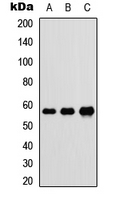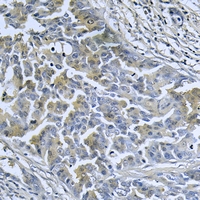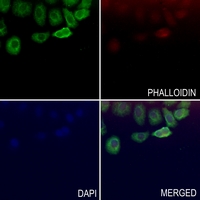Description: Rabbit polyclonal antibody to DnaJC3 Immunogen: KLH-conjugated synthetic peptide encompassing a sequence within the center region of human DnaJC3. The exact sequence is proprietary. Purification: The antibody was purified by immunogen affinity chromatography. Clonality: Polyclonal Form: Liquid in 0.42% Potassium phosphate, 0.87% Sodium chloride, pH 7.3, 30% glycerol, and 0.01% sodium azide. Dilution: WB (1/500 - 1/1000), IH (1/50 - 1/100), IF/IC (1/50 - 1/200) Gene Symbol: DNAJC3 Alternative Names: P58IPK; PRKRI; DnaJ homolog subfamily C member 3; Endoplasmic reticulum DNA J domain-containing protein 6; ER-resident protein ERdj6; ERdj6; Interferon-induced, double-stranded RNA-activated protein kinase inhibitor; Protein kinase inhibitor of 58 kDa; Protein kinase inhibitor p58Entrez Gene (Human): 5611Entrez Gene (Mouse) : 100037258Entrez Gene (Rat) : 63880SwissProt (Human): Q13217SwissProt (Mouse) : Q91YW3SwissProt (Rat) : Q9R0T3Storage/Stability : Shipped at 4°C. Upon delivery aliquot and store at -20°C for one year. Avoid freeze/thaw cycles.
-
 Western blot analysis of DnaJC3 expression in HEK293T (A), Raw264.7 (B), H9C2 (C) whole cell lysates.
Western blot analysis of DnaJC3 expression in HEK293T (A), Raw264.7 (B), H9C2 (C) whole cell lysates. -
 Immunohistochemical analysis of DnaJC3 staining in human colorectal cancer formalin fixed paraffin embedded tissue section. The section was pre-treated using heat mediated antigen retrieval with sodium citrate buffer (pH 6.0). The section was then incubated with the antibody at room temperature and detected using an HRP conjugated compact polymer system. DAB was used as the chromogen. The section was then counterstained with haematoxylin and mounted with DPX.
Immunohistochemical analysis of DnaJC3 staining in human colorectal cancer formalin fixed paraffin embedded tissue section. The section was pre-treated using heat mediated antigen retrieval with sodium citrate buffer (pH 6.0). The section was then incubated with the antibody at room temperature and detected using an HRP conjugated compact polymer system. DAB was used as the chromogen. The section was then counterstained with haematoxylin and mounted with DPX. -
 Immunofluorescent analysis of DnaJC3 staining in SGC7901 cells. Formalin-fixed cells were permeabilized with 0.1% Triton X-100 in TBS for 5-10 minutes and blocked with 3% BSA-PBS for 30 minutes at room temperature. Cells were probed with the primary antibody in 3% BSA-PBS and incubated overnight at 4 °C in a hidified chamber. Cells were washed with PBST and incubated with a AF488-conjugated secondary antibody (green) in PBS at room temperature in the dark. Phalloidin - AF594 was used to stain the cytoplasm (red). DAPI was used to stain the cell nuclei (blue).
Immunofluorescent analysis of DnaJC3 staining in SGC7901 cells. Formalin-fixed cells were permeabilized with 0.1% Triton X-100 in TBS for 5-10 minutes and blocked with 3% BSA-PBS for 30 minutes at room temperature. Cells were probed with the primary antibody in 3% BSA-PBS and incubated overnight at 4 °C in a hidified chamber. Cells were washed with PBST and incubated with a AF488-conjugated secondary antibody (green) in PBS at room temperature in the dark. Phalloidin - AF594 was used to stain the cytoplasm (red). DAPI was used to stain the cell nuclei (blue).

 Anti-DnaJC3 Antibody
Anti-DnaJC3 Antibody  Datasheet
Datasheet MSDS
MSDS